What is an ingrown toenail?
An ingrown toenail can occur when the hard nail plate causes a wound in the soft flesh around the nail. It’s like a splinter of nail, and usually starts at the front edge of the nail. They can be very painful and bleed or become infected as bacteria enters the wound. The toe will be hot red and swollen, and there may be an overgrowth of tissue around the nail due to irritation of the wound.
What causes ingrown toenails.
Common causes are direct trauma from “picking” your nails, tight footwear or stubbing your toe, and cutting your nails badly leaving a sharp corner on the nail. Long term pressure from a thickened or curved toenail can also cause a wound. See more causes in this video.
Swollen toes and sweaty feet weaken the skin around the nail which can make you more susceptible to ingrown toenails.
How to treat an ingrown toenail.
The key to healing an ingrown toenail is removing the piece of nail causing the problem, and reducing the pressure on the area. This can be done by your podiatrist using specialised instruments, and depending on the severity a local anaesthetic may be required.
Your podiatrist will also advise on care of the toenail, and the right footwear to assist. You can book online to see a podiatrist.
Why not just take antibiotics?

If your toe is infected it will be red and swollen, it might be discharging pus, and may even smell bad. Antibiotics will help to reduce the infection, but not the cause. The reason you catch the infection is that there is a piece of toenail acting as a foreign body, causing a wound, and allowing the entry of bacteria. Antibiotics may help to reduce the redness and swelling, but removal of the piece of nail is still essential. Without this you may find you are taking repeated courses of antibiotics, without seeing a permanent improvement.
In short, antibiotics treat infection, but they don’t treat ingrown toenails.
What about Cutting a “V” in the middle?
It’s an old tale that cutting a “V” shape in the middle of a toenail will cause it sides to grow towards each other. The idea is that this will relieve or prevent ingrown toenails. Unfortunately toenails grow from the roots, a bit like grass. This means that the front edge of the nail will not change regardless of how you cut it. People have described relief from cutting a “V” but this will simply due to the nail being shorter. Any pressure on the end of an ingrown nail will cause pain, so it is important to keep the nail as short as possible, but no need to cut a “V” shape.
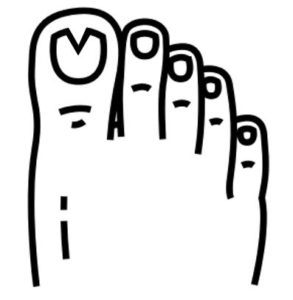
Toenail Bracing to help a misshaped or ingrown toenail.
If non-invasive treatment is preferred there is an option to use wire or acrylic bracing devices in an attempt to bend the nail. These are firmly attached to the top surface of the nail, and they “pull” the edges of the nail up to prevent them from digging in. This process can take 6 months as the new nail has to grow out. The braces are usually replaced every 4-6 weeks. You can see the process here.
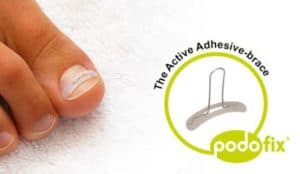
Permanently fix an ingrown toenail.
If you find that ingrowing toenails just won’t go away there is a solution. Podiatrists carry out a minor procedure under local anaesthetic to remove the offending piece of nail and prevent it growing back again.

©FootMedic Podiatry (our friends in Glasgow)
The procedure is carried out in out clinic, and your visit will last about an hour. You should arrange transport to get you home, and bring open toed footwear to use after the procedure.
Your podiatrist will review your history and current medications, and may check the circulation in your toes to ensure good healing.
The local anaesthetic is usually a couple of injections at the base of the toe. It takes a few minutes to go numb, and we will check by poking the toe with something sharp!
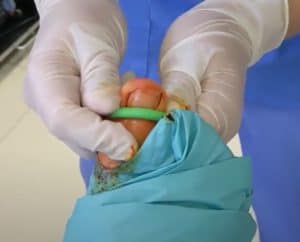
©FootMedic Podiatry (our friends in Glasgow)
A tourniquet may be applied to reduce the blood flow in the toe. Your toe will be swabbed with antiseptic so the the skin and nail are as germ free as possible, then the troublesome section of nail will be removed. After this we apply a strong chemical for a few minutes to kill the nail root. You won’t feel a thing!
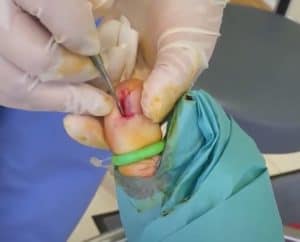
©FootMedic Podiatry (our friends in Glasgow)
Lastly we will remove the tourniquet and apply a dressing to keep the wound clean and protected.
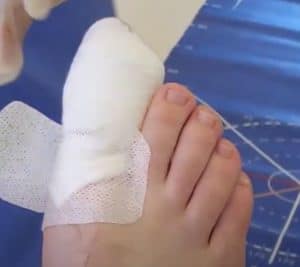
©FootMedic Podiatry (our friends in Glasgow)
We will continue to check the toe every few days in the early stages of healing. You will need to keep the dressing dry and in place, avoid pressure on the toe (from closed footwear) as much as possible, and follow the advice of your podiatrist about rest and analgesia. Over the counter paracetamol is usually advised if necessary, and generally just for the first 24 hours after the procedure. The aim is to avoid infection and get the toe healed as quickly as possible so that you can return to normal activities. Healing times vary from person to person, but we have found the average to be around 3 three weeks.
